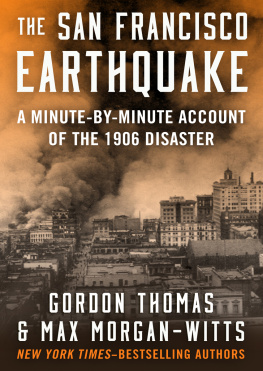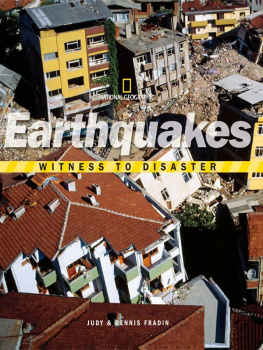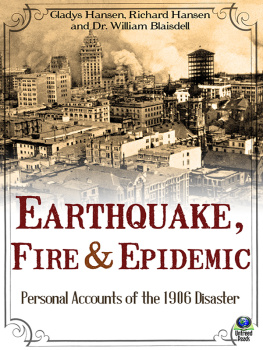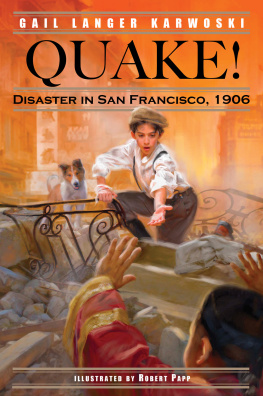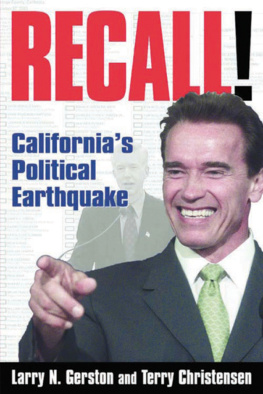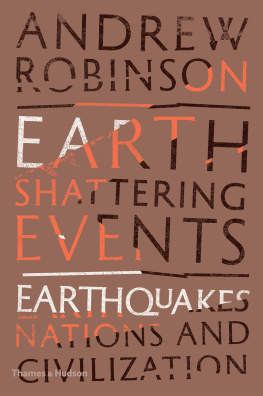INTRODUCTION
On August 23, 2011, my son Joshua was at his new job in an office building in New York City. At 1:50 p.m., the person sitting at the desk next to his said to him, Would you please not kick my desk with your foot?
Joshua replied, Im not kicking your desk. Its an earthquake.
As the room shook, his co-workers cried, We dont have earthquakes in New York!
On the Richter scale, the quake measured 5.9, and its epicenter was in Virginia. It rattled the nerves of New Yorkers but didnt do much damage there. Although East Coast earthquakes are uncommon, theyre not all that rare, though most are in the 2.1 to 3.0 range. As a native-born Californian, Joshua was familiar with earthquakes, so the one on August 23 didnt faze him. It was minor league compared to the 6.6 Northridge earthquake on January 17, 1994.
I have been personally involved in several California earthquakes and include my own observations in the narrative. I have done this in the spirit of knowing that when natural disasters occur, everyone has a story to tell, and so I include my own.
The first chapter of this book examines why California has more earthquakes than any other state in the nation. The final chapter offers suggestions on how to prepare for a major earthquake, and be assured, theres one coming. Not sure when, but its out there.
THE PACIFIC RIM AND
THE RING OF FIRE
Country singer Johnny Cash famously defined passionate love as a ring of fire. Theres a broader definition of the Ring of Fire, and it more than matches the perils of Cashs song.
Take a map of the world and, starting with the southern tip of Chile, draw a sort of wobbly horseshoe up the Pacific coast of South America, Central America and North America. Then head west across the Aleutian Islands to Japan and China and south to the Philippines, Indonesia, New Zealand and Antarctica. Add a stirrup for the horseshoe by going west across Southeast Asia through India and on to the Middle East, and finally, head west across the Mediterranean region to the Atlantic Ocean. It doesnt look much like a ring, but the squiggly line carries an important message: it goes through the most seismically active regions in the world.
One of the most catastrophic explosions in recorded history occurred on the island of Krakatoa (also spelled Krakatau) in the south Pacific when a volcano erupted in 1883. The explosion was so tremendous that volcanic ash altered the worlds climate for several years. Volcanoes, earthquakes and tsunamis (gigantic waves) were partners in wreaking major destruction, death and injury. On the coast of South America, Chile has the dubious distinction of being where the largest earthquake ever was recorded. In 1960, the Villarica volcano erupted, creating an earthquake with a magnitude 9.6 that went on for ten minutes. (The 1906 San Francisco quake lasted around 47 seconds.) The quake generated a tsunami that sent thirty-five-foot waves across the Pacific Ocean to devastate the city of Hilo, Hawaii, killing sixty-one people. Other tsunamis reached as far as China, and Chile itself sustained damage from the destructive trio of volcano, quake and tsunami. The volcanic eruption also caused landslides in the Andes Rangefortunately in uninhabited areas. An estimated six thousand people in Chile died in the quake, and property damage ran between $600 to $800 millionsome $6.4 billion in present-day dollars.
More recently, Chile suffered from an 8.8 quake on February 27, 2010, and an 8.2 on April 1, 2014.
Peru, Ecuador, Costa Rica, Nicaragua, Guatemala and Mexico have experienced major quakes, resulting in large loss of life and property. On September 19, 1985, a magnitude 7.0 quake killed five thousand people in Mexico City and caused between $3 to $4 billion in damages. Four hundred buildings were destroyed, and three thousand more were severely damaged. The Mexican government established an alert systemthe Sistema de Alerta Sismicausing electronic messages from sensors, but the system isnt perfect. As of 2016, there were still some eighty families living in camps, survivors of the 1985 quake, still awaiting relocation. Mexico holds evacuation drills every September 19.
Similar statistics apply to other Latin American countries. Ecuador suffered a severe quake on April 16, 2013, with 661 dead and more than 27,000 people injured. On December 23, 1972, Managua, the capital city of Nicaragua, had a 6.2 quake that killed 6,000, injured 20,000 and left 250,000 people homeless. Although a 6.2 magnitude would be considered moderate to severe in California, Managua had many houses and buildings that were more than forty years old and structurally incapable of withstanding the quake. An offshore quake by Nicaragua killed 116 people in 1992; it was followed by a tsunami. Costa Rica experienced a 7.6 quake on September 5, 2012, followed by more than 1,600 aftershocks. El Salvador and Panama also felt this quake. Costa Ricas high standards of building construction spared the country much damage, and few casualties were reported. Guatemala experienced an offshore quake on November 7, 2012, just two months after the Costa Rica quake. At magnitude 7.4, the quake killed 39 people. It was felt in Chiapas, Mexico, north of Guatemala.
Such quakes ruin the economy of the regions, as agriculture and industry are severely affected. But the Ring of Fire doesnt stop in Latin America. New Zealand, where The Lord of the Rings trilogy was filmed, has numerous active volcanoes. One area in particular, the Auckland volcanic field, has at least forty active volcanoes. In recent years China, Japan, Indonesia, Nepal and the Philippines (where somewhere in its islands there are almost constant quakes) have experienced major earthquakes, along with Iran. A 6.6 quake struck Bam, Iran, around 2:00 a.m. on December 26, 2003, killing more than thirty thousand people when their homes collapsed on them. Ten years later, on April 16, 2013, a 7.7 hit Saravan, Iran.
On April 25, 2015, a 7.8 quake struck Nepal, killing almost 9,000 people, injuring at least 18,000 and leaving more than 2 million people homeless. The quake caused avalanches that killed 20 mountain climbers, injured 120 and wiped out entire villages. Severe aftershocks caused more destruction. Much of the disaster was caught on camera and can be seen on the PBS program


